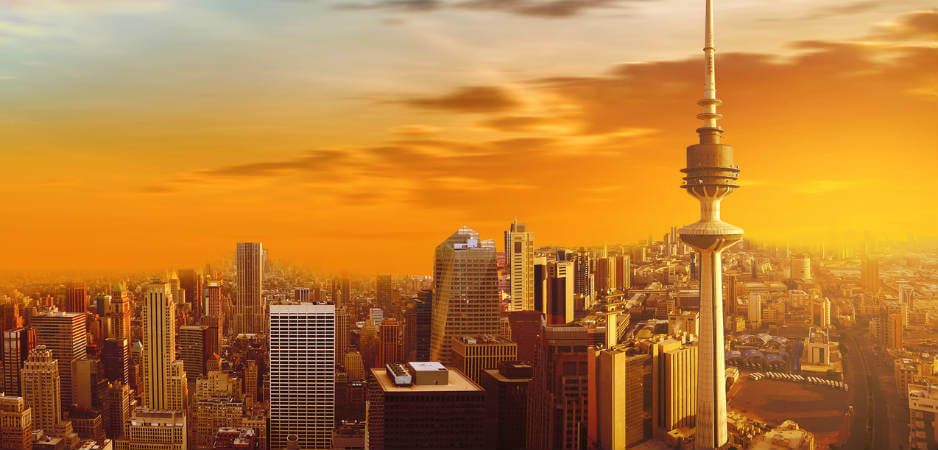Kuwait unveils an ambitious plan to diversify its economy.
Mired in an era of cheap oil, Kuwait is looking for answers. Along with its petrochemical-rich neighbors, Kuwait has been dealing with this harsh reality since 2014. Throughout previous decades, Kuwaitis consistently relied on oil to fund government spending and to grow their immense sovereign wealth fund. The Kuwait Investment Authority (KIA) holds nearly $592 billion in assets.
When global oversupply caused prices to drop below $40 per barrel, Kuwaiti officials had to accept an ineluctable truth. Their state could no longer rely on commodity prices as the sole source of wealth for government coffers. Like Saudi Arabia, Kuwait has unveiled a plan, dubbed Kuwait 2035 and marketed as the “New Kuwait.” Sheikh Mohammad Abdullah Al Mubarak Al Sabah, the minister of state for cabinet affairs, described the plan as a set of “initiatives that will transform our economy, create jobs, attract foreign direct investments and facilitate knowledge transfer in the fields of renewable energy, information technology, and the services sector.”
Transforming the Economy
Founded in 1953, KIA, the world’s oldest sovereign wealth fund, manages surpluses from oil revenue. The fund adheres to the Santiago Principles, which ensure transparency, risk management and accountability, regulatory accountability and financial stability. Following 16 years of surpluses, Kuwait posted a large budget deficit in 2015-2016, and the government recently approved a 2017-2018 budget that projects a deficit for the third consecutive year. Finance Minister Anas Al Saleh estimated the coming shortfall to be $21.6 billion. This figure is an improvement from the 2016-2017 fiscal year (which ends on April 1, 2017), during which the shortfall is projected to be $29 billion. Rising oil prices are the cause of this uptick.
The New Kuwait development plan is designed to transform Kuwait’s economy through 164 strategic programs. The plan features seven “pillars” which will ensure diversification and growth. The first pillar targets public administration to reform bureaucratic practices and reinforce transparency, accountability and efficiency. The second pillar seeks to diversify the economy and reduce dependency on oil revenues, which comprise around 90% of government revenue. Third pillar focuses on infrastructure development. The remaining pillars target domestic living standards, public healthcare, the domestic labor market and Kuwait’s global position.
The objectives of this National Development Plan (NDP) are consistent with other regional development plans, such as Saudi Arabia’s Vision 2030. Government officials hope to increase direct foreign investment and to position Kuwait as a hub for the global petrochemical industry. They also look to invest in tourism and infrastructure, target high-population areas through urban development programs and introduce social and economic empowerment programs.
For foreign investors, Pillar 2, which targets economic diversification, demonstrates appropriate opportunity. Most obvious are programs targeting the tourism and technology sectors. Investors should also heed infrastructure and labor-market developments.
Technology, Tourism and Infrastructure
The KIA has recently demonstrated a desire to invest in technology through several high-profile investments. Three years ago, the KIA established a $2 billion portfolio for venture capital investments, closing deals with Alkem Laboratories, Apttus, Tyba, and NantHealth. Managing Direct Bader Al Saad argued that the KIA must “take more risk in order to maintain the returns,” indicating a shift toward active management.
Kuwaiti investment in the tourism sector has also grown. According to the World Travel and Tourism Council (WTTC), tourist arrivals are expected to increase from 270,000 in 2014 to 440,000 by 2024. The KIA needs to expand capacity and has allowed foreign corporations to provide the hotel space. The Four Seasons will open its first Kuwaiti hotel at the Burj Alshaya Centre this year. The Mercure Kuwait, Hilton Olympia Kuwait and a Grand Hyatt are expected to follow, opening by 2020.
Infrastructure will remain a top priority for Kuwaiti politicians. Cabinet Affairs Minister Sheikh Mohammad Al Abdullah Al Sabah spoke of elaborate mega-projects during the New Kuwait presentation. These include the Silk City, a planned urban area in northern Kuwait; the 37-kilometer Subiya Causeway, that will connect Shuwaikh Port with Subiya New Town; and the ongoing development of Boubiyan Island into a container harbor and gateway commercial seaport.
Government funding is not sufficient to finance these ambitious projects and public-private partnerships are necessary. Kuwait’s finance minister, Anas Al Saleh, stressed the necessity to focus on infrastructure investment. Managing Director Bader Al Saad declared: “To write a big check, you need projects in infrastructure. Otherwise there’s no size. You need scale.” Materials and construction firms should reap the immediate benefits of these projects. Services and tourism will follow.
Labor market reform is also a key focus of New Kuwait. The Ministry of Social Affairs and Labor estimates that expatriates comprise nearly 70% of Kuwait’s population. The plan hopes to reduce this number to 60% by 2030. The large expatriate population (3.1 million compared to 1.33 million Kuwaiti citizens) has elicited vitriol from some lawmakers. One MP described them as “colonial settlers” and called for a tax on expatriates for “walking on the street.” While government investment in education will help a new generation of Kuwaitis join the workforce, corporations must remain wary of the state’s plan to limit foreign workers.
The New Kuwait plan is an anticipated reaction to the commodities slide of 2014. Kuwait’s 2010 launch of a $107 billion plan to invest in energy, transport and health infrastructure engendered squabbling between the government and parliament and brought lackluster results.
It is clear that political stability will attract foreign investment. Otherwise, projects by foreign companies are subject to review and abrogation by officials. Despite this risk, the country has a favorable business environment. Accommodative fiscal policy will aid rapid implementation of public-private partnerships and other foreign investment. Perhaps the slack in commodities revenues will finally provide impetus for capital spending and project development.
If New Kuwait is executed properly, Kuwait’s economy will diversify and expand. Until Kuwaiti officials can prove capable of avoiding delays, however, political deadlock is the main downside risk.
*[This article was originally published by Gulf State Analytics, a partner institution of Fair Observer.]
The views expressed in this article are the author’s own and do not necessarily reflect Fair Observer’s editorial policy.
Photo Credit: ArloMagicman
Support Fair Observer
We rely on your support for our independence, diversity and quality.
For more than 10 years, Fair Observer has been free, fair and independent. No billionaire owns us, no advertisers control us. We are a reader-supported nonprofit. Unlike many other publications, we keep our content free for readers regardless of where they live or whether they can afford to pay. We have no paywalls and no ads.
In the post-truth era of fake news, echo chambers and filter bubbles, we publish a plurality of perspectives from around the world. Anyone can publish with us, but everyone goes through a rigorous editorial process. So, you get fact-checked, well-reasoned content instead of noise.
We publish 2,500+ voices from 90+ countries. We also conduct education and training programs
on subjects ranging from digital media and journalism to writing and critical thinking. This
doesn’t come cheap. Servers, editors, trainers and web developers cost
money.
Please consider supporting us on a regular basis as a recurring donor or a
sustaining member.
Will you support FO’s journalism?
We rely on your support for our independence, diversity and quality.







